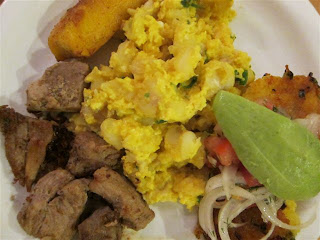Along the way we visited the cities/towns of Riobamba and Cuenca in Equador, saying "Adios" (Goodbye) to Equador along the way!
And what a descent that was!

Riobamba (Pop 182K, Elev 2,750m) is a shabby, unkept industrial town but features a long straight cobbled-stone main road with many colonial buildings and 3 main plazas. Riobamba is surrounded by Andean volcano's and is the base for Chimborazo, Equador's highest mountain at 6,310m, it is 2/3rds the hight of Everest! Chimborazo is also recognised as the farthest point from the centre of the earth given the "equatorial buldge" of the Earth! Worth googling to see if the buldge is big enough to surpass Everest!
The area around Riobamba is also dominated by fruit growing areas featuring the sweet "tree tomato" (drunk as a juice) and the grenadilla (passionfruit). Did not do much in this town except two runs and my first tub of ice-cream in a long time! Our hotel door-to-door journey from Riobamba to Cuenca took 7hrs via 2 taxis, 2 buses and 1 van. Given the 6hr bus ride with no stops, Maureen and I stocked up on white wine, cheese and olives from the night before and enjoyed a civilised but shakey lunch as we watching the steep farmed hills of the Andes roll past. The landscape was definately softening from the harsh jagged peaks and cavenous valleys of the Quito north. Many of the villages were so high that they were covered in cloud, making for some awe-inspiring scenery.
Cuenca (Pop 470K, Elev 2,530m, Est 1557) is a more, rustic, charming city with narrow cobblestone streets, a river running throught the centre and surrounded by a ring road and more mountains. It is UNESCO protected and home to the famous white with black band "Panama Hat". Cuenca is known as the "Athens of Equador" given it is a city of learning with 3 universities and the home of Equadorian poetry. It certainy looks better than Athens with multiple church domes amongst colourful colonial buildings - more like the "Florence" of Equador! Dinner on our first night (20JAN) featured the local "Plato Typica" off roast pork pieces with corn and scrambled egg, chips and avocado! It is here we discovered the local export Pilsener - very malty and severely refreshing.
The following day (21JAN), Maureen and I hit the streets and in classic Golfin style we visited the entire city by noon covering, 2 plazas, 3 churches, the river, some piss-weak Inca Ruins and of course some shopping. The highlight was the massive1885 granite built New Cathedral with 3 huge capollas and a massive crucifix under an even bigger gold painted sepulchure (see pictures).
In the afternoon we took a local bus and within 30min we were soaking in the local thermal public baths of Cuenca fuelled by some seismic activity beneath smaller dormant surrounding volcanoes.
A great way to complete the day!
Our final day in Cuenca began at 8:30am with a 2hr bus ride to Ingapirca which features the ruins of a small Inca setllement from the 16th centrury.
Given the drama of a 3hr bus ride back (first bus broke down) and the lack of enough guides to explain the ruins (which are not that intact) I reckon it was a waste of a day. Better to go to the National Park for a bush walk. The only point of interest was the face of an Inca in the side of a hill (see photo).
At 6:45am we farewelled our Cuenca Hotel and took a taxi to the bus station to start our 5hr journey down from the Andes to Huaquillas at the Equadorian border. Even though this crazy lead-foot bus driver turned our morning yoghurt into lunchtime cheese, the scenery on our way down from the Andes was fabulous: narrow valleys, towering peaks, very green slopes, full of farms, small villages and brightly dressed indigenous women. The final descent to the Equadorian coastal plain was simply the best to date.
Massive open valleys with cliff-edge dirt roads, peaks hugged by clouds and raging rivers below. This was made possible by a detour caused by a rain-induced landslide covering the main road. My camera worked overtime. Finally we got to the Equadorian border post (crappy building and the worst toilet to date!) where we spent 20min getting our passport stamped and another 20min waiting for the Peruvian bus. Another 20min entering Peru which was an atco shed with everyone queued outside in the hot equatorial sun! Lucky it was not raining. After 45min the aqua green Pacific showed itself - a sight for sore eyes - I had not seen it since arriving in South America.
NEXT BLOG: to cover the Peruvian Pacific Coastline to Lima due 27JAN.
ACKNOWLEDGEMENTS: 1) My thanks to Maureen for taking most of my crazy dance sequences for the film, especially the one under the New Cathedral main door which took some time because of dumb-arse people walking in front of the camera.
NOTES TO SELF: 1) Buses in Equador remind me of Greece 40 years ago - there are no set stops, people just get on and off along the way, including locals selling stuff. This is what makes the journeys so long. A 200km trip can take up to 5hrs!















